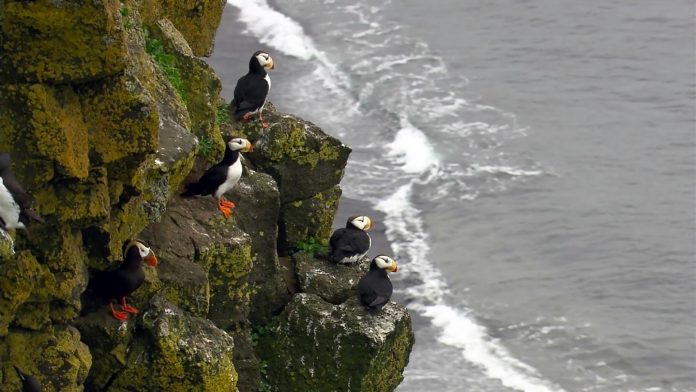view more
Credit: Daniel Zatz (CC BY-NC 2.0 – https://creativecommons.org/licenses/by-nc/2.0/)
New insight on how four species of seabirds have developed the ability to cruise through both air and water has been published today in the open-access journal eLife.
The study reveals that these birds, from the Alcidae family which includes puffins, murres and their relatives, produce efficient propulsive wakes while flying and swimming. This means that the animals likely spend relatively low amounts of metabolic energy when creating the force they need to move in both air and water. The findings suggest that alcids have been optimised for movement in very different environments through the course of their evolution.
“Birds that use their wings for ‘flight’ in air and water are expected to fly poorly in both environments compared to those that stick to either air or water only,” explains first author Anthony Lapsansky, a PhD candidate at the Field Research Station at Fort Missoula, Division of Biological Sciences, University of Montana, US. “In other words, these jacks-of-all-trades should be the masters of none. Interestingly, however, alcids seem to contradict this notion of a trade-off between aerial and aquatic flight performance, and we wanted to investigate this further.”
To gain a better understanding of the potential evolutionary trade-offs between these two types of flight, Lapsansky and his team tested whether alcids exhibit ‘efficient Strouhal numbers’ when flying in water and air. Animals move in these environments by using oscillating appendages. The Strouhal number describes the frequency at which an animal produces pulses of force with these appendages to power its movement. Only a narrow range of Strouhal numbers are efficient – if a bird flaps its wings too fast or too slow, for a given amplitude and flight speed, then it wastes energy. But most birds have converged on this narrow range of Strouhal numbers, meaning that selection has tuned them to exhibit efficient flapping and swimming movements.
Additionally, Lapsansky and his team were interested to see whether birds that fly in air and water use their muscles in the same way in both environments. “Muscles typically consist of fibers which are tuned for specific activities, but this hardly seems possible when the same muscles are used for movement in two drastically different environments,” Lapsansky says. “We hypothesised that alcids maintain efficient Strouhal numbers and consistent stroke velocities across air and water, which would allow them to mitigate the costs of being able to cruise through both environments.”
The team used videography to measure the wing movements of four species of alcids that differ substantially in body mass (450g to 1kg) and represent distant branches of the alcid family tree. Their measurements showed that alcids cruise at Strouhal numbers between 0.10 and 0.40 in both air and water, similar to animals that stick to air or water only, but flap their wings approximately 50% slower in water. This suggests that the birds either contract their muscles at inefficient velocities or maintain a two-geared muscle system, highlighting a clear cost to using their wings for movement in air and water.
“Our work provides detailed new insight into how evolution has shaped alcid flight in response to competing environmental demands in air and water,” concludes senior author Bret Tobalske, Professor and Director of the Field Research Station at Fort Missoula, Division of Biological Sciences, University of Montana. “Further research is now needed to understand the necessary changes that take place in the flight muscles of these birds to allow them to transition between air and water and back again.”
###
Reference
The paper ‘Alcids ‘fly’ at efficient Strouhal numbers in both air and water but vary stroke velocity and angle’ can be freely accessed online at https:/
Media contact
Emily Packer, Senior Press Officer
eLife
01223 855373
About eLife
eLife is a non-profit organisation created by funders and led by researchers. Our mission is to accelerate discovery by operating a platform for research communication that encourages and recognises the most responsible behaviours. We work across three major areas: publishing, technology and research culture. We aim to publish work of the highest standards and importance in all areas of biology and medicine, including Ecology and Evolutionary Biology, while exploring creative new ways to improve how research is assessed and published. We also invest in open-source technology innovation to modernise the infrastructure for science publishing and improve online tools for sharing, using and interacting with new results. eLife receives financial support and strategic guidance from the Howard Hughes Medical Institute, the Knut and Alice Wallenberg Foundation, the Max Planck Society and Wellcome. Learn more at https:/
To read the latest Ecology research published in eLife, visit https:/
And for the latest in Evolutionary Biology, see https:/
TDnews















